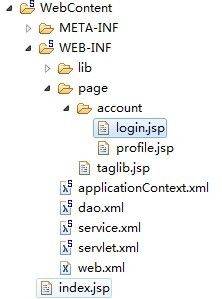Spring 注解学习手札(三) 表单页面处理
昨天小歇一天,看着两篇博客迅速飙升的点击率,十分欣慰。今天来研究一下表单页面的处理问题。

相关参考:
Spring 注解学习手札(一) 构建简单Web应用
Spring 注解学习手札(二) 控制层梳理
Spring 注解学习手札(三) 表单页面处理
Spring 注解学习手札(四) 持久层浅析
Spring 注解学习手札(五) 业务层事务处理
Spring 注解学习手札(六) 测试
Spring 注解学习手札(七) 补遗——@ResponseBody,@RequestBody,@PathVariable
Spring 注解学习手札(八) 补遗——@ExceptionHandler
如果要说表单,最简单的就是用户登录页面了!估计大多数做B/S出身的兄弟可能写的第一个表单就是登录表单了! 今天,我也不例外,做一个登录验证实现!
今天,我也不例外,做一个登录验证实现!
首先,改造一下账户类Account,增加一个id字段:
Account.java
接下来,为了协调逻辑处理,我们改造接口AccountService及其实现类AccountServiceImpl:
AccountService.java
我们暂时抛开AccountDao该做的事情,在AccountServiceImpl中完成数据提取:
AccountServiceImpl.java
先来一个账户信息的展示,构建一个控制器ProfileController:
ProfileController.java
@RequestMapping(value = "/profile.do")为该控制器绑定url(/profile.do)
@RequestMapping(method = RequestMethod.GET)指定为GET请求
model.addAttribute("account", account);绑定账户
return "account/profile";跳转到“/WEB-INF/page/account/porfile.jsp”页面
对应构建这个页面:
porfile.jsp
账户信息已经绑定在response的属性上。自然,使用<c:out />标签就可以获得账户信息内容。
访问地址 http://localhost:8080/spring/profile.do?id=1,结果如图所示:

接着构建一个登录控制器LoginController
LoginController.java
分段详述,先说初始化表单:
@RequestMapping(method = RequestMethod.GET)指定了GET请求方式,这与POST表单提交相对应!
model.addAttribute("account", account);绑定账户对象,也就是这个登录表单对象
return "account/login";指向登录页面
再看登录方法:
@RequestMapping(method = RequestMethod.POST)绑定POST表单提交请求
@ModelAttribute("account") Account account绑定表单对象。
最后,再来看看页面:
login.jsp
注意, <form:form commandName="account">必须指明 commandName,且与表单初始化、提交方法中的表单对象名称保持一致!
页面目录结构如下图所示:

在页面中,我加入了一部分css效果,这部分代码我就不在这里唠叨了,大家可以看源码!
登录试试,如图:

用户名:snwolf 密码:zlex
如果登录成功,我们就会跳转到之前的账户信息页面!
注解的确减少了代码的开发量,当然,这对于我们理解程序是一种挑战!如果你不知道原有的SpringMVC的流程,很难一开始就能摆弄清楚这些内容!
完整代码见附件!
相关参考:
Spring 注解学习手札(一) 构建简单Web应用
Spring 注解学习手札(二) 控制层梳理
Spring 注解学习手札(三) 表单页面处理
Spring 注解学习手札(四) 持久层浅析
Spring 注解学习手札(五) 业务层事务处理
Spring 注解学习手札(六) 测试
Spring 注解学习手札(七) 补遗——@ResponseBody,@RequestBody,@PathVariable
Spring 注解学习手札(八) 补遗——@ExceptionHandler
相关参考:
Spring 注解学习手札(一) 构建简单Web应用
Spring 注解学习手札(二) 控制层梳理
Spring 注解学习手札(三) 表单页面处理
Spring 注解学习手札(四) 持久层浅析
Spring 注解学习手札(五) 业务层事务处理
Spring 注解学习手札(六) 测试
Spring 注解学习手札(七) 补遗——@ResponseBody,@RequestBody,@PathVariable
Spring 注解学习手札(八) 补遗——@ExceptionHandler
如果要说表单,最简单的就是用户登录页面了!估计大多数做B/S出身的兄弟可能写的第一个表单就是登录表单了!
首先,改造一下账户类Account,增加一个id字段:
Account.java
/** * 2010-1-23 */ package org.zlex.spring.domain; import java.io.Serializable; /** * 账户 * * @author <a href="mailto:[email protected]">梁栋</a> * @version 1.0 * @since 1.0 */ public class Account implements Serializable { /** * */ private static final long serialVersionUID = -533698031946372178L; /** * 主键 */ private int id; /** * 用户名 */ private String username; /** * 密码 */ private String password; public Account() { } /** * @param id */ public Account(int id) { this.id = id; } // get、set方法省略 }
接下来,为了协调逻辑处理,我们改造接口AccountService及其实现类AccountServiceImpl:
AccountService.java
/** * 2010-1-23 */ package org.zlex.spring.service; import org.springframework.transaction.annotation.Transactional; import org.zlex.spring.domain.Account; /** * 账户业务接口 * * @author <a href="mailto:[email protected]">梁栋</a> * @version 1.0 * @since 1.0 */ @Transactional public interface AccountService { /** * 获得账户 * * @param username * @param password * @return */ Account read(String username, String password); /** * 获得账户 * * @param id * @return */ Account read(int id); }
我们暂时抛开AccountDao该做的事情,在AccountServiceImpl中完成数据提取:
AccountServiceImpl.java
/** * 2010-1-23 */ package org.zlex.spring.service.impl; import org.springframework.beans.factory.annotation.Autowired; import org.springframework.stereotype.Service; import org.zlex.spring.dao.AccountDao; import org.zlex.spring.domain.Account; import org.zlex.spring.service.AccountService; /** * 账户业务 * * @author <a href="mailto:[email protected]">梁栋</a> * @version 1.0 * @since 1.0 */ @Service public class AccountServiceImpl implements AccountService { @Autowired private AccountDao accountDao; @Override public Account read(String username, String password) { Account account = null; if (username.equals("snowolf") && password.equals("zlex")) { account = new Account(); account.setId(1); account.setUsername(username); account.setPassword(password); } return account; } @Override public Account read(int id) { Account account = new Account(); account.setId(1); account.setUsername("snowolf"); account.setPassword("zlex"); return account; } }
先来一个账户信息的展示,构建一个控制器ProfileController:
ProfileController.java
/** * 2010-1-26 */ package org.zlex.spring.controller; import org.springframework.beans.factory.annotation.Autowired; import org.springframework.stereotype.Controller; import org.springframework.ui.ModelMap; import org.springframework.web.bind.annotation.RequestMapping; import org.springframework.web.bind.annotation.RequestMethod; import org.springframework.web.bind.annotation.RequestParam; import org.zlex.spring.domain.Account; import org.zlex.spring.service.AccountService; /** * 账户信息控制器 * * @author <a href="mailto:[email protected]">梁栋</a> * @version 1.0 * @since 1.0 */ @Controller @RequestMapping(value = "/profile.do") public class ProfileController { @Autowired private AccountService accountService; /** * 账户信息展示 * * @param id * @param model * @return */ @RequestMapping(method = RequestMethod.GET) public String profile(@RequestParam("id") int id, ModelMap model) { Account account = accountService.read(id); model.addAttribute("account", account); // 跳转到用户信息页面 return "account/profile"; } }
@RequestMapping(value = "/profile.do")为该控制器绑定url(/profile.do)
@RequestMapping(method = RequestMethod.GET)指定为GET请求
model.addAttribute("account", account);绑定账户
return "account/profile";跳转到“/WEB-INF/page/account/porfile.jsp”页面
对应构建这个页面:
porfile.jsp
<fieldset><legend>用户信息</legend>
<ul>
<li><label>用户名:</label><c:out value="${account.username}" /></li>
</ul>
</fieldset>
账户信息已经绑定在response的属性上。自然,使用<c:out />标签就可以获得账户信息内容。
访问地址 http://localhost:8080/spring/profile.do?id=1,结果如图所示:

接着构建一个登录控制器LoginController
LoginController.java
/** * 2010-1-25 */ package org.zlex.spring.controller; import org.springframework.beans.factory.annotation.Autowired; import org.springframework.stereotype.Controller; import org.springframework.ui.ModelMap; import org.springframework.web.bind.annotation.ModelAttribute; import org.springframework.web.bind.annotation.RequestMapping; import org.springframework.web.bind.annotation.RequestMethod; import org.zlex.spring.domain.Account; import org.zlex.spring.service.AccountService; /** * 登录控制器 * * @author <a href="mailto:[email protected]">梁栋</a> * @version 1.0 * @since 1.0 */ @Controller @RequestMapping(value = "/login.do") public class LoginController { @Autowired private AccountService accountService; /** * 初始化表单 * * @param model * @return */ @RequestMapping(method = RequestMethod.GET) public String initForm(ModelMap model) { Account account = new Account(); model.addAttribute("account", account); // 直接跳转到登录页面 return "account/login"; } /** * 登录 * * @param account * @return */ @RequestMapping(method = RequestMethod.POST) public String login(@ModelAttribute("account") Account account) { Account acc = accountService.read(account.getUsername(), account .getPassword()); if (acc != null) { return "redirect:profile.do?id=" + acc.getId(); } else { return "redirect:login.do"; } } }
分段详述,先说初始化表单:
/**
* 初始化表单
*
* @param model
* @return
*/
@RequestMapping(method = RequestMethod.GET)
public String initForm(ModelMap model) {
Account account = new Account();
model.addAttribute("account", account);
// 直接跳转到登录页面
return "account/login";
}
@RequestMapping(method = RequestMethod.GET)指定了GET请求方式,这与POST表单提交相对应!
model.addAttribute("account", account);绑定账户对象,也就是这个登录表单对象
return "account/login";指向登录页面
再看登录方法:
/**
* 登录
*
* @param account
* @return
*/
@RequestMapping(method = RequestMethod.POST)
public String login(@ModelAttribute("account") Account account) {
Account acc = accountService.read(account.getUsername(), account
.getPassword());
if (acc != null) {
return "redirect:profile.do?id=" + acc.getId();
} else {
return "redirect:login.do";
}
}
@RequestMapping(method = RequestMethod.POST)绑定POST表单提交请求
@ModelAttribute("account") Account account绑定表单对象。
最后,再来看看页面:
login.jsp
<fieldset><legend>登录</legend><form:form commandName="account"> <form:hidden path="id" /> <ul> <li><form:label path="username">用户名:</form:label><form:input path="username" /></li> <li><form:label path="password">密码:</form:label><form:password path="password" /></li> <li> <button type="submit">登录</button> <button type="reset">重置</button> </li> </ul> </form:form></fieldset>
注意, <form:form commandName="account">必须指明 commandName,且与表单初始化、提交方法中的表单对象名称保持一致!
页面目录结构如下图所示:

在页面中,我加入了一部分css效果,这部分代码我就不在这里唠叨了,大家可以看源码!
登录试试,如图:

用户名:snwolf 密码:zlex
如果登录成功,我们就会跳转到之前的账户信息页面!
注解的确减少了代码的开发量,当然,这对于我们理解程序是一种挑战!如果你不知道原有的SpringMVC的流程,很难一开始就能摆弄清楚这些内容!
完整代码见附件!
相关参考:
Spring 注解学习手札(一) 构建简单Web应用
Spring 注解学习手札(二) 控制层梳理
Spring 注解学习手札(三) 表单页面处理
Spring 注解学习手札(四) 持久层浅析
Spring 注解学习手札(五) 业务层事务处理
Spring 注解学习手札(六) 测试
Spring 注解学习手札(七) 补遗——@ResponseBody,@RequestBody,@PathVariable
Spring 注解学习手札(八) 补遗——@ExceptionHandler